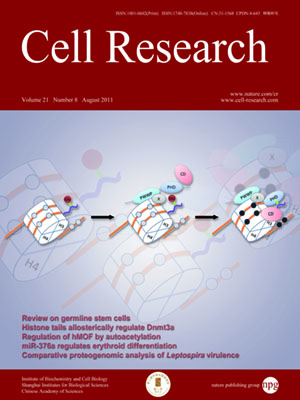
Volume 21, No 8, Aug 2011
ISSN: 1001-0602
EISSN: 1748-7838 2018
impact factor 17.848*
(Clarivate Analytics, 2019)
Volume 21 Issue 8, August 2011: 1164-1171
REVIEWS
Epigenetic modifications and self-renewal regulation of mouse germline stem cells
Jiyoung Lee1,2 and Takashi Shinohara3,4
1Global Center of Excellence Program, Tokyo Medical and Dental University, Tokyo 113-8510, Japan
2PRESTO, Japan Science and Technology Agency (JST), 4-1-8 Honcho Kawaguchi, Saitama 332-0012, Japan
3Department of Molecular Genetics, Graduate School of Medicine, Kyoto University, Kyoto 606-8501, Japan
4CREST, JST, Japan
Correspondence: Jiyoung Lee,(jlee.gcoe@tmd.ac.jp)
Germline stem (GS) cells were established from gonocytes and spermatogonia of postnatal mouse testes. GS cells proliferate in the presence of several kinds of cytokines, and a small percentage of GS cells also show spermatogonial stem cell (SSC) activity, i.e., they differentiate into sperm after being transplanted into infertile mouse testes without endogenous spermatogenesis. Interestingly, in GS cell culture, we also found that pluripotent stem cells (multipotent germline stem cells (mGS cells)) could be derived and these mGS cells do not have normal androgenetic genomic imprinting marks that are shown in GS cells, e.g., H19 hypermethylation. A new culture system for fetal male germ cells (embryonic GS (eGS) cells) has also been recently developed. Although these cells exhibited SSC potential, the offspring from cultured cells showed heritable imprinting defects in their DNA methylation patterns. In an attempt to understand the self-renewal machinery in SSCs, we transfected H-Ras and cylin D2 into GS cells, and successfully reconstructed the SSC self-renewal ability without using exogenous cytokines. Although these cells showed SSC activity in germ cell transplantation assays, we also found development of seminomatous tumors, possibly induced by excessive self-renewing signal. These stem cell culture systems are useful tools not only for understanding the mechanisms of self-renewal or epigenetic reprogramming but also for clarifying the mechanism of germ cell tumor development.
Cell Research (2011) 21:1164-1171. doi:10.1038/cr.2011.111; published online 12 July 2011
FULL TEXT | PDF
Browse 2068


